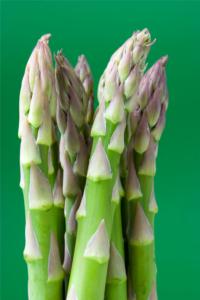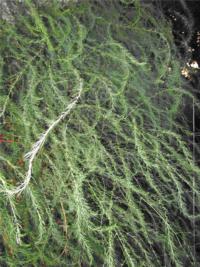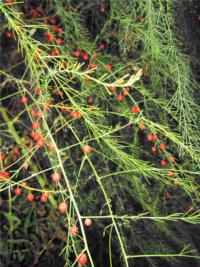
Spring spears
Most of the vegetables found in the typical vegetable garden are annuals, meaning you must replant them every year to get a new harvest. Asparagus is unique in the world of edible crops because it’s perennial, providing 15+ years of tasty spears after a single planting. The spears burst through the ground in early spring, when gardeners select which to eat and which to let grow into a five-foot ferny backdrop for the summer vegetable garden. Come winter, after the foliage turns golden and the seed pods bright red, it’s time to cut it down and allow the rains to soak into the roots until the cycle starts over again.
Growing asparagus takes a little patience, since it requires serious soil preparation and waiting a few years before harvesting. But once established, it’s a carefree addition to your edible garden.

Summer fronds
Getting startedAsparagus requires a permanent and well prepared home, so selecting a site is critical. Choose a weed-free area that’s in full or part sun and that will not be crowded out by other plants. Consider building one raised bed just for your asparagus. Take care to select a site where neighboring plants will not become shaded out once the asparagus reaches five-feet tall by mid-summer. Asparagus enjoys Marin’s cool, humid summers, which make south and west Marin suitable growing areas.
Asparagus takes up a fair amount of space: each 18 x 18-inch plant produces around a half pound of asparagus per season. That means you need five to 20 plants per person if you want to eat asparagus all season. Most Marin gardeners don’t have that kind of space to spare, opting instead to carve out whatever plot they can and relishing the spears that pop up every season.
Soil preparationFall is a great time to get your asparagus beds ready for planting. Work the soil a foot or more deep, turning in plenty of compost and/or rotted manure. (If the ground is too hard to turn, consider soaking it with a hose first.) Failure to prepare the soil adequately will result in spindly crops and increased odds of pest problems. Bottom line? Don't skip this step.

Fall seed pods
Seeds or crowns? Asparagus is not a plant that you see in nurseries very often. Instead, many gardeners order seeds or crowns online. Most gardeners plant asparagus crowns, which are the roots of the plant that look like tangled white bunches. Crowns must be planted as soon as they are received, so it’s important to have the planting area prepared. Now here’s the hard part: Asparagus plants must be left unharvested for at least three years. Harvest too early and you risk weakening the plant and reducing future yields.
Starting asparagus from seed has become more popular because of the increasing number of varieties available from seed companies. However, seeds definitely take patience and finesse. Pre-sprout the seeds in spring by putting them between damp paper towels until they swell. Sow these “primed” seeds into a growing container filled with plenty of organic matter, thinning the sprouts to three inches apart. Asparagus seedlings aren’t speedy; expect this process to take around three months, after which they should be well protected for at least a year before being planted in their permanent home. Then, like crowns, you must resist the urge to harvest for at least three years.
Whether you choose seeds or crowns, there are plenty of varieties available including old standards like Jersey and Mary Washington. The University of California has developed a popular variety, UC 157, specifically for mild-winter areas such as Marin’s. If you want to grow “white” asparagus, simply cover the spears with soil as they grow. Cutting off their light supply will keep them white.
Care and plantingIn late fall or early winter, dig trenches at least one foot deep and wide in your already prepared planting area. Fill the trenches about half full with more compost and/or well rotted manure and dig in a balanced organic fertilizer. Cover all this up with two inches of soil. The top of the trenches should still be a few inches below ground level. Build small mounds every 18 inches and place the seedlings or crowns on these mounds, carefully spreading the roots out. Cover the plants with two inches of soil. As the plant grows, gradually fill in with soil until you are at ground level. Keep the soil moist and weed free for the first year. Thereafter, water more during the fern season than during the harvest season. When the plants die back in winter, cut them down to the ground and compost or discard the stalks.
HarvestFinally, it’s time to harvest. If you’ve waited those painful three years, your fourth year’s harvest should be prime picking. Asparagus is one of the earliest spring crops, its deep purple-green fingers poking up from the bare earth like something out of a creature feature. Harvest spears that are at least as thick as a pencil by cutting or snapping them off right at soil level. Resist the temptation to harvest for longer than two weeks the first time. Remember, those unharvested spears that turn into five-foot tall ferny fronds are still supplying the roots with energy.
Unpleasant surprisesAsparagus is relatively problem-free in Marin, but be on the watch for pests and diseases just in case. Especially in Marin’s foggy locales, rust can cause fuzzy red spots. To avoid rust, plant where air circulation is good and irrigate at ground level. Remove diseased shoots and dispose. If your plants take on a blue-green cast, you might have an aphid infestation. If so, spray with insecticidal soap or horticultural oil. Asparagus beetles may feed on young shoots and ferns. Dust plants with bone meal or rock phosphate as a preventative measure, or use an insecticidal soap if an infestation occurs.
Contributors:Marie Narlock, Faith Brown
Sources:Golden Gate Gardening by Pam Peirce, Growing Asparagus in the Garden by UC Davis Vegetable Research and Information Center
 Spring spears
Spring spears Summer fronds
Summer fronds Fall seed pods
Fall seed pods


